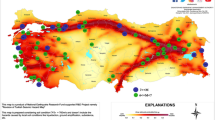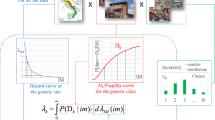Abstract
Reconnaissance observations are presented on the building damage caused by the May 19, 2011, Kütahya–Simav earthquake in Western Turkey as well as an overview of strong ground motion data recorded during the earthquake is given. According to Disaster and Emergency Management Presidency of Turkey, the magnitude of the earthquake is 5.7 in local magnitude scale. Although the earthquake can be regarded as a moderate event when considering its magnitude and strong motion recordings, it caused excessive structural damage to buildings in Simav district and several villages in the near vicinity. During the field investigation, different types of structural damage were observed mainly in the reinforced concrete frame buildings with infill walls and masonry buildings with various types of construction materials. Observed damage resulted from several deficiencies in structural and non-structural components of the buildings. Poor construction materials and workmanship, non-conforming earthquake-resistant design and construction techniques and non-ductile detailing are the main reasons for such an extensive damage, as observed in many past earthquakes in Turkey.


























Similar content being viewed by others
References
AFAD (2011) Internet page of the Disaster and Emergency Management Presidency (AFAD), Prime Ministry, Republic of Turkey. http://www.afad.gov.tr
Akkar S, Çağnan Z (2010) A local ground-motion predictive model for Turkey, and its comparison with other regional and global ground-motion models. Bull Seismol Soc Am 100(6):2978–2995
Akkar S, Aldemir A, Askan A, Bakır S, Canbay E, Demirel İO, Erberik MA, Gülerce Z, Gülkan P, Kalkan E, Prakash S, Sandıkkaya MA, Sevilgen V, Ugurhan B, Yenier E (2011) 8 March 2010 Elazığ–Kovancılar (Turkey) earthquake: observations on ground motions and building damage. Seismol Res Lett 82(1):42–58
Allen TI and Wald DJ (2007) Topographic slope as a proxy for seismic site conditions (V 30S ) and amplification around the globe. U.S. Geological Survey, Open File Report 2007-1357, p 69
Arslan MH, Korkmaz HH (2007) What is to be learned from damage and failure of reinforced concrete structures during recent earthquakes in Turkey. Eng Fail Anal 14:1–22
Boore DM, Atkinson GM (2008) Ground-motion prediction equations for the average horizontal component of PGA, PGV, and 5%-damped PSA at spectral periods between 0.01 s and 10.0 s. Earthq Spectra 24(1):99–138
Bozkurt E (2001) Neotectonics of Turkey—a synthesis. Geodin Acta 14:3–30
Campbell KW, Bozorgnia Y (2008) NGA ground motion model for the geometric mean horizontal component of PGA, PGV, PGD and 5 % damped linear elastic response spectra for periods ranging from 0.01 to 10 s. Earthq Spectra 24(1):139–171
Doğangün A (2004) Performance of reinforced concrete buildings during the May 1, 2003 Bingöl earthquake in Turkey. Eng Struct 26:841–856
Dogangun A, Sezen H (2012) Seismic vulnerability and preservation of historical masonry monumental structures. Earthq Struct 3(1):83–95
ED-AFAD (2011) Monthly earthquake report, May 2011. (in Turkish), Earthquake Department, Disaster and Emergency Management Presidency (AFAD), Prime Ministry, Republic of Turkey. http://www.deprem.gov.tr/Sarbis/Doc/Aylik_Rapor/MAYIS_2011_WEB.pdf
ED-AFAD (2012a) Internet page of the Earthquake Department, Disaster and Emergency Management Presidency (AFAD), Prime Ministry, Republic of Turkey. http://www.deprem.gov.tr
ED-AFAD (2012b) Internet page of the National Strong Motion Network, Earthquake Department, Disaster and Emergency Management Presidency (AFAD), Prime Ministry, Republic of Turkey. http://kyh.deprem.gov.tr
Emre Ö, Duman TY (2011) Preliminary evaluation of 19 May 2011 Simav (Kütahya) Earthquake (Mw: 5.8). (in Turkish), General Directorate of Mineral Research and Exploration, Ankara, Turkey. http://www.mta.gov.tr/v2.0/duyuru/duyurular/19Mayis2011simav_depremi.pdf
Kalkan E, Gülkan P (2004) Site-dependent spectra derived from ground motion records in Turkey. Earthq Spectra 20(4):1111–1138
Kütahya Governorship (2011). Internet page of the Kütahya Governorship, Republic of Turkey. http://www.kutahya.gov.tr
NDAT-AFAD (2012) Internet page of the National Disaster Archieve of Turkey, Disaster and Emergency Management Presidency (AFAD), Prime Ministry, Republic of Turkey. http://www.afet.gov.tr/tuaa
Power M, Chiou B, Abrahamson N, Bozorgnia Y, Shantz T, Roblee C (2008) An overview of the NGA project. Earthq Spectra 24(1):3–21
Şaroğlu F, Emre Ö, Kuşcu İ (1992) Active fault map of Turkey. General Directorate of Mineral Research and Exploration, Turkey
Seyitoğlu G (1997) The Simav graben: an example of young E-W trending structures in the late Cenozoic extensional system of western Turkey. Turk J Earth Sci 6:135–141
Sezen H, Whittaker AS, Elwood KJ, Mosalam KM (2003) Performance of reinforced concrete buildings during the August 17, 1999 Kocaeli, Turkey earthquake, and seismic design and construction practice in Turkey. Eng Struct 25:103–114
Turkish Earthquake Code (TEC) (2007) Specification for buildings to be built in seismic zones. Ministry of Public Works and Settlement, Government of Republic of Turkey
Ural A, Doğangün A, Sezen H, Angın Z (2012) Seismic performance of masonry buildings during the 2007 Bala, Turkey earthquakes. Nat Hazards 60:1013–1026
USGS (2012) Internet page of the Global V 30S Map Server. U.S. Geological Survey. http://earthquake.usgs.gov/hazards/apps/vs30/
Wells DL, Coppersmith KJ (1994) New empirical relationships among magnitude, rupture length, rupture width, rupture area, and surface displacement. Bull Seismol Soc Am 84(4):974–1002
Westaway R (1990) Block rotation in western Turkey 1. Observational evidence. J Geophys Res 95(B12):19857–19884
Acknowledgments
We thank the anonymous reviewers for their detailed review of the manuscript and providing valuable comments and suggestions. Special thanks are extended to Professor Polat Gülkan at Çankaya University and Dr. Erol Kalkan at USGS for their valuable comments and suggestions. We also thank Bekir Murat Tekin and Recai F. Kartal at AFAD for their help in preparing the maps, and T. Selçuk Köksal at AFAD for his help during field inspections.
Author information
Authors and Affiliations
Corresponding author
Rights and permissions
About this article
Cite this article
Yılmaz, N., Avşar, Ö. Structural damages of the May 19, 2011, Kütahya–Simav earthquake in Turkey. Nat Hazards 69, 981–1001 (2013). https://doi.org/10.1007/s11069-013-0747-2
Received:
Accepted:
Published:
Issue Date:
DOI: https://doi.org/10.1007/s11069-013-0747-2




